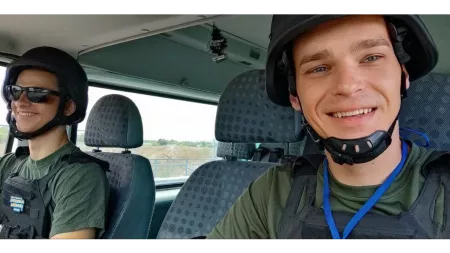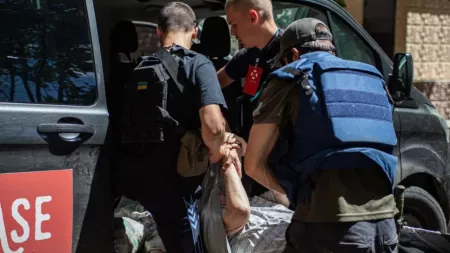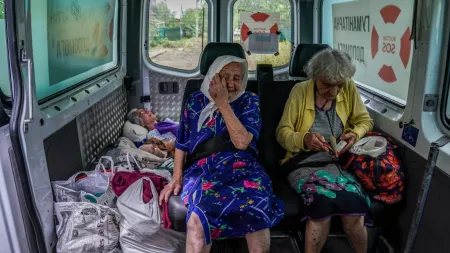Mykola, 19, and his 20-year-old Ford Transit are almost the same age. Mykola removes the rear passenger seats for patients who cannot sit but have to lie down. He then checks his documents, walks around the car several times to inspect it and looks underneath it. The car’s windows are covered with a tape that, in addition to visibility, should also protect against flying shrapnel in the event of an explosion.
Today’s journey is long. He and his partner are picking up five people with limited mobility from a town near Bakhmut, an area with active fighting in the East of Ukraine. He is an evacuation driver for the humanitarian organization Vostok-SOS, a CARE partner. Over the past year, Vostok-SOS has evacuated more than 35,000 people with limited mobility and people with disabilities from the areas with active fighting. The youngest rescued person was 13 days old, the oldest was 98 years old.
Since May Mykola has been part of the Vostok-SOS team. "All my friends and relatives are involved in volunteering or helping Ukraine. I was looking for opportunities to be useful. At first, I volunteered, and helped to distribute food," says Mykola. Despite his young age, the look on his face shows determination, he is confident and ready to do a job that not everyone can do. “I remember my first day well. It was my 19th birthday. I was worried because it was also my first mission. On the way there, there was an explosion just 500 meters away,” remembers Mykola.

A dangerous trip for the others' safety
Even in today's conditions in Ukraine, the risk of dying in a car accident is much higher than dying from being hit by a rocket. Mykola takes both risks every day. Every day, he drives more than 300 kilometres to bring people to safety. Before each drive, he receives clear coordinates for the people to be picked up. Mykola takes the car for maintenance because any breakdown on the road can cost someone's life.
In just over six months, he has evacuated more than 3,000 people. The most current evacuation trips include those who could not leave earlier. Among them are elderly people who have lived in these regions all their lives and don’t want to leave their homes and people with disabilities who simply cannot be picked up sooner because of the long evacuation lines. Currently, an average of about one hundred people leave the dangerous areas of the Donetsk region every day, and at least 350 people leave the Kherson region daily. Some of them are evacuated due to the work of drivers such as Mykola.
“Unfortunately, we also saw death. Due to the difficult humanitarian situation in the fighting areas, many people, do not have access to vital medicines. Sometimes, we evacuate people who are already in an insulin coma or have other serious issues due to lack of medicines", says Mykola. “When we arrive, their condition is already so serious that they simply cannot endure the long journey. Five people died in our car. And that is very difficult to experience.”

Despite the dangers that lurk in the active fighting areas, Mykola and his partner face other difficulties. “We repeatedly had to carry people downstairs with limited mobility who weighed more than 100kg from the 9th floor of a building”, recalls Mykola. Sometimes they cannot enter the apartment because the paralyzed person is locked inside and there is no one nearby who can open the door. “Often elderly people refuse to evacuate because they cannot leave behind what they have worked for all their lives", Mykola continues.
In one house Mykola searches for a cat for more than five hours under shelling because the owner refuses to leave without the beloved pet. “We do not have enough time to reach everyone, because the explosions find their homes before us”, says Mykola. "Every trip we take is a new challenge, but every time you are hugged by the people we rescued, you realize that you have to keep doing your job", Mykola concludes.
CARE and Vostock-SOS provide safe shelter for the evacuated. They furnish the shelters with kitchen appliances, beds, mattresses, cabinets, tables, and chairs in order for the displaced to have a safe home.
